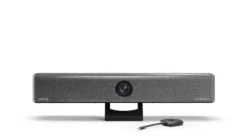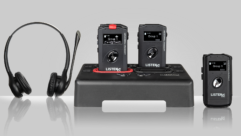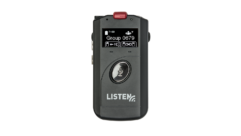
SVC Podcast – Show Notes – Show 129-1:
In this edition of the SVC Podcast, SVC Contributing Editor Bennett Liles talks with Gino Sigismondi of Shure regarding the course entitled Wireless Mics: The New Spectrum Landscape that he will be teaching at Infocomm. Gino outlines what will be covered and provides some tips on wireless mic system installation and troubleshooting. In the course, he will provide the latest information on the spectrum auctions and reallocation.
Links of interest:
- Infocomm Course Listings and Session Search
- Shure Advanced Wireless Seminars
- Shure Wireless Workbench software
Download Podcast Here:
https://s3.amazonaws.com/nb-svc/public/public/129-1_Wireless_Ed_at_Infoc…
From Sound & Video Contractor Magazine, this is the SVC Podcast with Gino Sigismondi. Show notes for the podcast are available on the web site of Sound &Video Contractor Magazine at svconline.com.
The wireless microphone spectrum is changing again and one way to keep up with the latest developments is by taking a course at Infocomm. Gino Sigismondi from Shure is going to be teaching Wireless Mics: The New Spectrum Landscape and he’s here to give us a little preview of what he’s going to have for us. That’s coming up next on the SVC Podcast.
Gino, it’s great to have you on the SVC Podcast from Shure where a big part of what you do is to educate people on the more IT aspects of AV.
Yep.
You’re going to be teaching a course there on Wireless Mics and The New Spectrum Landscape I think is the name of the course.
Yes. That’s a title that I’ve been using for several years because it seems every year we’re faced with a new spectrum landscape, so it definitely applies all the time. I didn’t teach the course last year, but I did it for probably a good maybe six or seven years running before that. And it always is a pretty popular one, I think, because of understandably how much confusion there is out there from people about all these changes that we’ve been facing in the UHF television spectrum. [Timestamp: 1:31]
Yeah, and it’s been referred to lately as a “fluid situation” and you could just about teach a new course on this about every six months for the last three years or so.
It kind of feels that way sometimes.
Well, let’s get right into that. Where are we right now with the RF spectrum allocations for wireless mics?
When I teach the course we go through kind of the history of how we got to the point that we’re at right now, and the most recent issue that we’ve been wrangling with here is what they’re referring to as the Incentive Auction. It’s looking at auctioning off more of UHF television spectrum extending now down into the 600MHz range. It was 700MHz a few years ago, but now they have this incentive auction idea, which is a new concept. It’s different now that they are thinking about incentivizing broadcasters to participate on a voluntary basis in the auction rather than just taking it away and auctioning it like they did last time. So it’s a fairly complex new type of auction and there’s a lot of change happening sometimes on a weekly basis as more entities get involved to try and figure out how and when this is exactly all going to work. [Timestamp: 2:38]
Yeah and what makes it real interesting of course, there are a lot of politics at work and there some are powerful forces on both sides.
Yes. Yes.
We have outfits like The Grand Ole Opry pitted against companies like AT&T and Verizon.
Yep, and one of the kind of interesting things is that AT&T, Verizon and those other companies have all the money to buy up all the spectrum, but they just dumped a whole bunch of money on a recent auction, the AWS-3 auction. Billions of dollars were already spent on that, so there’s already some debate about are they going to be able to have enough credit to actually spend billions more in this next auction. That’s one of the fine nuances that come into play here among many other moving parts. [Timestamp: 3:25]
Right. There’s a lot at stake and you never know what’s going to come out of it with powerful forces pulling in opposite directions on this. I think it’s going to be interesting. I’m very glad you’re teaching this course and I guess you’re going to have to stay right on top of this right up to the day of the class.
Well, yeah, it’s always good to keep on top of it as much as possible, just being aware that nothing is set in stone yet and lots of things can change. We try to teach the course really as like okay, given the fact that it’s really uncertain what are the things that you can do today to try and best make sure that you’re poised no matter what happens, right? It’s like if a hurricane is bearing down on you, you do what you can to try and shield your house as best you can because you don’t know exactly when and where it’s going to hit, so you just try and prepare yourself. So we give you as many tools and techniques and recommendations as we can so that you’ll be okay in the long run. [Timestamp: 4:21]
And you probably have people with wireless mic installations out there who are blissfully unaware of all the things going on, or they want to be.
Yeah.
But there are a lot of more basic issues that you and Shure get into in terms of educating people and that’s just setting up a wireless mic system and installing it right. You’ve seen a lot of those I’m sure so what are the most common problems you see with wireless mic installations?
Well really when it comes to making a wireless microphone system work correctly, there’s really two aspects of it. There’s the aspect of choosing and coordinating your frequencies appropriately and then secondly making sure your antenna system is optimized. Whenever you have a wireless mic system that’s not working, assuming that it’s not broken and in need of repair or something like that – it’s a fully-functional system – if it’s not working it comes down to one of those two areas. So either you end up with someone who’s just kind of piled on wireless randomly over the years, buying more and more and not really coming up with an overall frequency plan, that’s going to be a huge problem. Or not scanning and finding for clear frequencies or consulting the proper resources to make sure you’re not operating on top of a TV channel or whatever. Those are very common problems. And then like I said, the second thing is antenna issues. Not remote mounting antennas that should be remote mounted, so maybe they’re locked up in a closet somewhere or worst of all inside of a metal rack or something like that. Or if they are remote mounted it’s the incorrect antenna in the wrong place with the wrong cable. These things kind of can pile up and sometimes it seems to work okay, but boy you’re right on the edge there; one little thing changes and the system’s not working any more. [Timestamp: 6:04]
Yeah, I guess it’s important just like with a high-powered transmitter to maintain the same impedance all the way down the line.
It’s funny you mention that. We just did a whole webinar – an hour-long webinar on this topic just the other day here on remote mounting antennas. One of the things that comes up again is we don’t typically get asked, “What kind of cable should I use?” People usually ask us, “How far away can I remote mount my antennas?” The answer is well, it depends on what kind of cable you use because a lot of people that install sound systems also do a lot of video/cable TV type of work and they have a lot of 75 ohm cable around. That’s what they tend to want to use for their wireless mic systems. But all professional wireless mic systems have 50 ohm antennas, 50 ohm inputs on the receivers, so you would want to use 50 ohm cable. That said using 75 ohm cable, if that’s what you do, that’s not the worst sin in the world. There are many things you could do that would make it a lot worse than that, but to your point anything you can do to try and give you a little bit of an edge, like using 50 ohm cable like we recommend, is something you probably want to keep in mind. But really, it’s not just about the impedance; it’s also about the quality of the cable. If you look at the RG number that is applied to any cable, whether it’s RG-58 or RG-6 or RG-8 or whatever it happens to be, that tells you something about the quality of the cable and you want to find the spec in terms of how much loss there is in the cable. It’s usually specified in dB per 100 feet. That’s what determines how far you can go because you really want to keep your losses under about 5 dB or so in the cable. Assuming you can do that then you can go as far as the cable will allow you based on its rating. So always check that out and that will go a long way towards helping you out. [Timestamp: 7:48]
So the planning is critical and getting it right from the beginning can save a lot of grief later.
Definitely. Yep. Always do your homework.
And one of the big things I guess over the past 10 years or so has been the addition of networking capability and of course that has affected just about everything in AV including wireless mic systems. How has that changed the game for those?
It can really speed up the frequency coordination process at a minimum. For example, when you have receivers that are networked together, if the receivers have scanning capabilities like most Shure systems now – almost every receiver has the ability to scan and find a clear frequency so that you know it’s on a good frequency. When these receivers are networked together, they’re all on the same frequency band, then you can have one receiver scan and find frequencies for all of your receivers and program them in an instant. And you know that now you’ve got good, clear, compatible frequencies for everything in your setup and it’s a one-time thing that you just do once. If your receivers aren’t networked, then you have to go and scan in each individual receiver. If you’ve got 20 wireless receivers, that can take awhile. So just from that kind of speed of setup aspect alone it’s a great advantage. But then once the receivers are networked together, many, many factors have control software that you can use and then get in and monitor and control everything in real time as well as do more advanced frequency coordination. So it becomes a really helpful thing to be able to put these things on a network and get that control. [Timestamp: 9:15]
And of course in Shure’s case, that software is Wireless Workbench so what can Wireless Workbench do for you?
Exactly those things. It allows you to inventory all of your systems, in other words create a list of everything that you have and name, categorize, tag, give them colors, whatever you need to do to just be able to have one space where you can look at see everything that’s part of your setup and then using that information to calculate good frequencies for all your wireless. And not just all of your Shure wireless. There are many other manufacturers’ systems parameters in there that you can add to your inventory so that you can coordinate for those as well because it’s a point that a lot of people have missed. You have to look at your whole RF ecosystem and account for everything when you’re coordinating frequencies and that’s whether it’s Shure or Shure and Sennheiser and Audio-Technica and Telex intercoms and what have you. It’s all got to be part of that coordination. Anything that’s in the UHF spectrum you need to consider. So you can do that within the frequency coordination aspects of Wireless Workbench. And then finally you’ve got the monitor section, which again gives you real time control and monitoring of all your networked Shure devices. [Timestamp: 10:29]
And that can come in handy when you find out that suddenly by default you are the wireless coordinator for an event simply because nobody else is doing it.
Yep. Having that software can go a long way towards helping you be successful there.
And these days we’re not just sending audio out of those mic transmitters but we’re transmitting digital information on battery levels and all types of other things. But one thing that surprises me is that we still have people say, in churches with volunteer tech people who still seem to think you can take one manufacturer’s transmitter and because it might tune to the same frequency, then use it with a different receiver but that’s when tone squelch comes into the picture.
Well that being a bad idea is getting worse now that we’re getting into digital wireless mic systems, right, because the digital encoding, the digital modulation that manufacturers use is vastly different. It’s not like in the days of FM analog where you could get it to work, it might sound funny if one manufacturer did the companding a little bit different, but it would kind of sort of work. But then you’d throw the tone code squelch on top of it, well now even that situation doesn‘t work. And for those of you who don’t know that that is, again a receiver that has a tone coded or tone key squelch, what that means is that the wireless mic transmitter produces a super audible tone. In the cases of our systems it’s like a 32KHz tone that the receiver is looking for in order to know that its desired transmitter is there and pass audio. So the receiver in a tone key squelch system stays totally silent no matter how much RF level it’s receiving on that frequency unless that tone key signal from the transmitter is there as well. It’s a great feature because that means that when you’re transmitters are turned off, even if your receivers are left on, nothing else will cause that receiver to open up and produce sound. So it’s a great feature and again, the tone key, it can be modulated to carry information like battery life and transmitter type and those sorts of things. But you’re right, if you take one manufacturer’s transmitter with tone key and try to use it with another manufacturer’s receiver with tone key, that’s probably not going to work. And then as I mentioned, when you’re talking about digital systems it’s probably not going to work at all. And if you go to a digital system that has encryption, which a lot of them are starting to add now too, well that, I mean when you turn on encryption with a wireless mic system that transmitter receiver pair is the only one in the world that will be able to communicate. So it gets more and more important to try and just yeah, keep it all together, keep it all in one family if you can. [Timestamp: 13:00]
Well, it’s gotten a lot more complex behind the scenes but hopefully that means it will be easier for one person to do things that used to take a whole crew. I can remember the old VHF systems and when you turned them off you could suddenly have a local DJ or something blasting through your sound system. But that doesn’t happen anymore.
Not so much.
And we’ve got outfits still operating on the 700MHz band and I guess they will just keep on with it until something happens. So what could happen?
Yeah, that’s an interesting point. We are aware that there are a lot of people out there who are still using wireless mics and 700MHz even those it’s been illegal for oh geez, almost five years now. Again, that’s a result of the auctions. So technically it’s illegal, right, and that should be the end of the discussion right there. You should not be operating wireless mics at 700MHz. It’s technically against the law to do so. However, if you are still able to operate successfully you’re still on borrowed time anyway because the entities like Verizon and AT&T that own that spectrum are getting more of services up and running in many markets in that band anyway and those are very powerful, very noisy signals that are going to interfere with your wireless microphone system. So even if you are able to keep it going for a little while, you’re not going to be able to keep it going for too much longer. And a lot of the justification that some people use for keeping operating there it’s like, “Well, the FCC is not going to catch me. They’re not out looking for me,” or whatever. The FCC doesn’t have a large enough enforcement bureau to be just randomly running around the country looking for people using 700MHz wireless microphones, but you can bet that Verizon is out there doing that. We have real examples of entities that have received letters from Verizon that are basically like a cease and desist and saying we know you’re using 700MHz wireless mics. If you don’t stop we are going to report you to the FCC, in which case they will have to send out a field agent and you could be fined a lot of money. It could be as much as $4,000.00 per microphone per day of violation. So just keep that in the back of your mind if you’re thinking you don’t quite want to buy a new wireless yet because this 700MHz one is still working. Maybe it’s time to think about upgrading. [Timestamp: 15:17]
And there are different ways to go with UHF and some systems that have gone up to the 2.4GHz band but we all need a course like the one you’re offering at Infocomm just to keep up with what’s happening on the wireless spectrum. As it looks now, you’ll have that on Thursday, June 18th from 2:30 to 4:30PM. I’ll be down there so maybe we’ll see each other then.
I hope so. That sounds great.
Thank you for being here with us for the SVC Podcast with Gino Sigismondi. Show notes are available on the website of Sound & Video Contractor Magazine at svconline.com. In Part 2 Chris Maione is going to tell us about his Infocomm course on Managing Multiple AV Facilities through a Central Control Room and Monitoring System. That’s on the next SVC Podcast.










